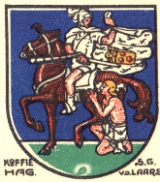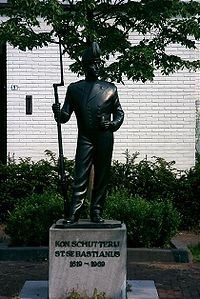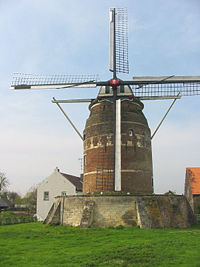
Gronsveld
Encyclopedia


Netherlands
The Netherlands is a constituent country of the Kingdom of the Netherlands, located mainly in North-West Europe and with several islands in the Caribbean. Mainland Netherlands borders the North Sea to the north and west, Belgium to the south, and Germany to the east, and shares maritime borders...
province of Limburg
Limburg (Netherlands)
Limburg is the southernmost of the twelve provinces of the Netherlands. It is located in the southeastern part of the country and bordered by the province of Gelderland to the north, Germany to the east, Belgium to the south and part of the west, andthe Dutch province of North Brabant partly to...
. It is part of the municipality of Eijsden
Eijsden
Eijsden is a place situated in the southern part of the Dutch province of Limburg. Until January 1st, 2011 it was the main village in a municipality with the same name. On that date this municipality merged with a neighbouring one, which resulted in the new Eijsden-Margraten municipality.Eijsden...
and situated southeast of the municipality of Maastricht
Maastricht
Maastricht is situated on both sides of the Meuse river in the south-eastern part of the Netherlands, on the Belgian border and near the German border...
, to which it is bordering.
Gronsveld was a separate municipality until 1982, when it was merged with Eijsden.
The municipality also included Rijckholt
Rijckholt
Rijckholt is a village in the Dutch province of Limburg. It is located in the municipality of Eijsden.Rijckholt was a separate municipality until 1943, when it was merged with Gronsveld.- External links :*...
, Eckelrade, Heugem (now part of Maastricht
Maastricht
Maastricht is situated on both sides of the Meuse river in the south-eastern part of the Netherlands, on the Belgian border and near the German border...
) and Honthem
Honthem
Honthem is a small village in the Netherlands, about 7 km from Maastricht....
.
The derivation of the name—which translates to "green field"—is uncertain, although it is commonly accepted to be quite literally referring to its evergreen pastures, and indeed the village is favourably situated at the foot of the Margraten Plateau which retains water in its bedrock. This provides for a constant gentle irrigation, and the lush clay soil carried here by the Meuse River
Meuse River
The Maas or Meuse is a major European river, rising in France and flowing through Belgium and the Netherlands before draining into the North Sea...
is excellent for growing fruit trees. Therefore, there are two fruit auction facilities in the village.
Gronsveld used to be an autonomous county until the end of the ancienne regime at the closing of the 18th century and was part of the imperial circle
Imperial Circle
An Imperial Circle comprised a regional grouping of territories of the Holy Roman Empire, primarily for the purpose of organizing a common defensive structure and of collecting the imperial taxes, but also as a means of organization within the Imperial Diet and the Imperial Chamber Court.Each...
of Westphalia
Westphalia
Westphalia is a region in Germany, centred on the cities of Arnsberg, Bielefeld, Dortmund, Minden and Münster.Westphalia is roughly the region between the rivers Rhine and Weser, located north and south of the Ruhr River. No exact definition of borders can be given, because the name "Westphalia"...
.
Its first and most famous count was Josse Maximilaan van Gronsveld né van Bronckhorst who fought in the Thirty Years' War
Thirty Years' War
The Thirty Years' War was fought primarily in what is now Germany, and at various points involved most countries in Europe. It was one of the most destructive conflicts in European history....
and invented the Gronsfeld cipher, a substitution cipher
Substitution cipher
In cryptography, a substitution cipher is a method of encryption by which units of plaintext are replaced with ciphertext according to a regular system; the "units" may be single letters , pairs of letters, triplets of letters, mixtures of the above, and so forth...
.
The lords, barons and counts of Gronsfeld had the right to mint their own coins which were frequently banned from circulation elsewhere because of their insufficient weight and/or alloy.
Gronsveld has a rich tradition when it comes to folklore. The local marching band Koninklijke Harmonie van Gronsveld est. 1835 and the Koninklijke Schutterij St. Sebastianus (= historic 'army') est. 1619 are the most well known parts of this.
Also, every year the village celebrates the traditional bronck, which dates back to the Middle Ages when the people of the village would honour God in order to get a good harvest.
The village is then ruled by a king and his queen. Every four years (most recent occurrence 2004) this position is 'battled' for. Who will be king is determined on Pentecost
Pentecost
Pentecost is a prominent feast in the calendar of Ancient Israel celebrating the giving of the Law on Sinai, and also later in the Christian liturgical year commemorating the descent of the Holy Spirit upon the disciples of Christ after the Resurrection of Jesus...
Monday by a contest where the candidates take turns shooting a wooden bird atop a long pole on the church square. Whoever manages to shoot the bird down will be king. Two weeks after Pentecost the actual celebrations start. During these three days (Sunday, Monday and Tuesday) the king and his army make their way through the whole village clearing road blocks (put there as a reminder of the problems they ran into in the old days) along the way. On Sunday there is also a mass and prosession through the village.
Two weeks after these celebrations, the king and queen treat the whole village to a so-called 'koffietafel' (literally: coffee table). Which includes drinks and the traditional limburgish pastry vlaai
Vlaai
Vlaai, better known as Limburgse vlaai, is a pie or tart consisting of a pastry and filling. Vlaai is usually 27—30 centimeters in diameter. Originally vlaai was created in Weert, Limburg and is therefore also known as Weertervlaai...
.
Historic buildings in Gronsveld include: the castle, the historic windmill from 1623 and the church built in the 18th century. Another beloved landmark of the village is the Savelsbos, a beautiful and protected forest in the hilly surroundings.

